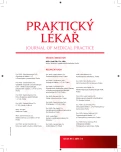Psychological aspects of malignant vasovagal syncopes
Authors:
V. Netík 1; D. Skorunka 2
Authors‘ workplace:
Terapeutické centrum v Jihomoravském kraji, Brno
Přednosta: MUDr. Jiří Dolák
1; Univerzita Karlova v Praze, Lékařská fakulta v Hradci Králové
Ústav sociálního lékařství
Přednosta: doc. MUDr. Svatopluk Býma, CSc.
2
Published in:
Prakt. Lék. 2015; 95(6): 272-275
Category:
Of different specialties
Overview
Vasovagal syncope is among the most common forms of physiological reflex based syncopes. Syncope is a sudden and transitory loss of consciousness on vasovagal basis. Its prevalence is estimated 3% in men and 3.5% in women. Almost one third of patients with the diagnosis suffer from an atypical form of vasovagal syncope called malignant vasovagal syncope (MVVS). In the paper, various aspects of this subtype are discussed. We focus primarily on psychological and so called psychosomatic aspects including psychiatric comorbidities, which occur frequently in patients with MVVS. We also describe the impact of the disease on quality of life of those patients.
Keywords:
malignant vasovagal syncope – psychological aspects – quality of life – therapy
Sources
1. Alboni P. Therapy of vasovagal syncope: to prevent the vasovagal reflex or to treat the impending reflex. Europace 2009; 6 : 776–778.
2. Bedard F, Marchand A, Kus T, D’Antono B. Vasovagal syncope and unexplained syncope: Concepts, treatments, and future perspectives. Can Psychol 2010; 51 : 257–268.
3. D’Antono B, Dupuis G, St-Jean K, et al. Prospective evaluation of psychological distress and psychiatric morbidity in recurrent vasovagal and unexplained syncope. J Psychosom Res 2009; 67(3): 213–222.
4. Flint B, Baker C, Freeston M, Newton JL. Level of psychosocial impairment predicts early response to treatment in vasovagal syncope. Europace 2008; 11(2): 231–236.
5. Gaynor D, Egan J. Vasovagal syncope, the common faint – what clinicians need to know. The Irish Psychologist 2011; 37(7): 178–179.
6. Goldemund D, Goldemund K. Synkopy, klasifikace, etiopatogeneze. Pediatrie pro praxi 2002; 1 : 6–9.
7. Gracie J, Baker Ch, Freeston MH, Newton JL. The role of psychological factors in the aetiology and treatment of vasovagal syncope. Indian Pacing Electrophysiol J 2004; 4(2): 79–84.
8. Grubb B. Neurocardiogenic syncope and related disorders of orthostatic tolerance. Circulation 2005; 111(22): 2997–3006.
9. Hartl P, Hartlová H. Psychologický slovník. Praha: Portál 2000.
10. Charon R. Narrative medicine; honoring the stories of illness. Oxford: OUP 2008.
11. Kapoor WN, Foruanto M, Hanusa BH, Schulberg HC. Psychiatric illnesses in patients with syncope. Am J Med 1995; 99 : 505–512.
12. Kolmáš P, Štípal R, Pešatová S, Hrabovská Z. Vazovagální synkopa – neměnná klinická jednotka? Interní Med 2002; 2 [online]. Dostupné z: www.solen.cz/pdfs/int/2002/02/10.pdf [cit. 2015-03-26].
13. Linzer M, Pontinen M, Gold DT, et al. Impairment of physical and psychosocial functioning in recurrent syncope. J Clin Epidemiol 1991; 44 : 1037–1044.
14. Linzer M, Gold DT, Pontinen M. Recurrent syncope as a chronic disease: preliminary validation of a disease specific measure of functional impairment. J Gen Intern Med 1994; 9 : 181–186.
15. Newton JL, Kenny RA, Baker CR. Cognitive behavioural therapy as a potential treatment for vasovagal/neurocardiogenic syncope-a pilot study. Europace 2003; 5 : 299–301.
16. Parry SW, Kenny RA. The management of vasovagal syncope. QJM 1999; 92 : 697–705.
17. Reybrouck T, Heidbuechel H, van de Werf H, Ector H. Tilt training: a treatment for malignant and recurrent neurocardiogenic syncope. Pacing Clin Electrophysiol 2000; 23(4): 493–498.
18. Rose MS, Koshman ML, Spreng S, Sheldon R. The relationship between health-related quality of life and frequency of spells in patients with syncope. J Clin Epidemiol 2000; 53(12): 1209–1216.
19. Shaffer C, Jackson L, Jarecki S. Characteristics, perceived stressors and coping strategies of patients who experience neurally mediated syncope. Heart Lung 2001; 30(4): 244–245.
20. Skorunka D. Narativní perspektiva v medicíně. Prakt. Lék. 2012; 92(7): 383–389.
21. Skorunka D. Psychoterapeutický přístup v medicíně. Prakt. Lék. 2011; 91(12): 718–722.
22. White M, Epston D. Narrative means to therapeutic ends. New York: Norton 1990
Labels
General practitioner for children and adolescents General practitioner for adultsArticle was published in
General Practitioner

2015 Issue 6
- Metamizole vs. Tramadol in Postoperative Analgesia
- Memantine in Dementia Therapy – Current Findings and Possible Future Applications
- Metamizole at a Glance and in Practice – Effective Non-Opioid Analgesic for All Ages
- What Effect Can Be Expected from Limosilactobacillus reuteri in Mucositis and Peri-Implantitis?
- Metamizole in perioperative treatment in children under 14 years – results of a questionnaire survey from practice
Most read in this issue
- Gastric surgery at present
- Betaglucans – immunomodulatory substances in prevention and support treatment
- Commission health assessment by medical assessor committees
- Patient with abdominal aortic aneurysm – diagnostics, follow-up and treatment in the ambulance of general practitioner
